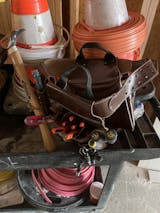In today's fashion-conscious world, leather accessories are prized possessions cherished for their timeless elegance and durability. Whether it's a sleek leather bag, a stylish wallet, or a pair of well-worn leather shoes, these accessories add a touch of sophistication to any ensemble. However, to ensure that your leather accessories retain their beauty and last for years to come, proper care and maintenance are essential. In this comprehensive guide, we'll explore the best practices for caring for and maintaining your leather accessories, covering everything from cleaning and conditioning to removing scratches and stains.
Understanding Leather
Before delving into the intricacies of leather care, it's important to understand the nature of leather itself. Leather is a natural material derived from animal hides, typically cowhide, sheepskin, or goatskin. It is prized for its strength, flexibility, and unique grain patterns, which vary depending on the animal species and the part of the hide used. Leather can be processed in different ways to achieve various finishes, such as smooth, textured, or embossed.
Leather Care Instructions
Proper care and maintenance are essential for preserving the beauty and integrity of your leather accessories. The following are some general care instructions to keep in mind:
- Cleaning Leather Accessories: Regularly remove dust and dirt from leather accessories using a soft, damp cloth. Avoid using harsh chemicals or abrasive cleaners, as these can damage the leather's surface. For stubborn stains, use a mild leather cleaner specifically formulated for the type of leather.
- Conditioning Leather for Longevity: Leather is susceptible to drying out and becoming stiff over time, especially in dry or humid environments. To prevent this, regularly apply a leather conditioner to nourish and moisturize the leather. Conditioning helps to restore the natural oils and keep the leather supple and soft.
- Protecting Leather from Damage: Avoid exposing leather accessories to excessive moisture, heat, or direct sunlight, as these can cause the leather to fade, crack, or warp. When not in use, store leather accessories in a cool, dry place away from heat sources and humidity. Use protective covers or dust bags to shield them from dust and scratches.
Essential Leather Care Products
Investing in high-quality leather care products is essential for maintaining the beauty and longevity of your leather accessories. Here are some essential products to consider:
- Leather Conditioners: Choose a leather conditioner that is suitable for the type of leather you have, whether it's smooth, suede, or nubuck. Apply the conditioner evenly using a soft cloth or sponge, and allow it to penetrate the leather for optimal results.
- Leather Cleaners: Look for gentle leather cleaners that are specifically formulated to remove dirt, stains, and grime without damaging the leather's surface. Avoid using household cleaners or solvents, as these can strip away the leather's natural oils and cause it to dry out.
- Leather Protectors: Consider applying a leather protector or waterproofing spray to your leather accessories to repel moisture and prevent stains. Be sure to test the product on a small, inconspicuous area of the leather first to ensure compatibility and avoid discoloration.
How to Clean Specific Leather Accessories
Different types of leather accessories require different cleaning methods and techniques. Here are some specific tips for cleaning common leather accessories:
- Cleaning Leather Bags and Purses: For smooth leather bags, use a mild leather cleaner and a soft brush or cloth to gently remove dirt and stains. For suede or nubuck bags, use a suede brush or eraser to lift away dirt and restore the nap.
- Maintaining Leather Wallets: Wipe down leather wallets with a damp cloth to remove surface dirt and oils. Avoid overstuffing wallets with cards and cash, as this can cause them to stretch and lose their shape over time.
- Caring for Leather Shoes and Belts: Use a soft brush or cloth to remove dirt and debris from leather shoes and belts. Apply a leather conditioner to keep them soft and supple, and use a waterproofing spray to protect them from moisture and stains.
Removing Scratches and Stains from Leather
Despite your best efforts to care for your leather accessories, scratches and stains may still occur. Here are some tips for removing them:
- Dealing with Surface Scratches: For minor surface scratches, gently rub the affected area with a soft cloth or your fingertips to buff out the scratch. For deeper scratches, apply a small amount of leather conditioner and gently massage it into the leather to help blend and camouflage the scratch.
- Removing Stubborn Stains: For stubborn stains, such as ink or oil, apply a small amount of leather cleaner to a clean cloth and gently dab the stain. Avoid rubbing the stain, as this can spread it further. Allow the cleaner to penetrate the stain for a few minutes, then wipe away excess cleaner with a damp cloth.
- Repairing Minor Damage: For more severe damage, such as tears or deep scratches, consider seeking professional leather repair services. A skilled leather craftsman can assess the damage and recommend appropriate repair techniques to restore your leather accessories to their original condition.
Tips for Home Leather Care
In addition to regular cleaning and conditioning, there are several preventive measures you can take to prolong the life of your leather accessories:
- DIY Leather Cleaning Solutions: Consider making your own DIY leather cleaning solutions using natural ingredients like vinegar, olive oil, or beeswax. These homemade cleaners are often gentler on the leather and less harmful to the environment.
- Preventative Measures for Leather Accessories: Avoid exposing leather accessories to harsh chemicals, sharp objects, or extreme temperatures, as these can cause damage to the leather's surface. Use protective covers or dust bags when storing leather accessories to shield them from dust and scratches.
- Storing Leather Items Properly: When not in use, store leather accessories in a cool, dry place away from direct sunlight and heat sources. Avoid folding or creasing leather items, as this can cause permanent damage to the leather's surface. Instead, hang leather jackets and coats on padded hangers, and store handbags and purses on shelves or in dust bags to maintain their shape and integrity.
Conclusion
In conclusion, proper care and maintenance are essential for preserving the beauty and longevity of your leather accessories. By following the tips and techniques outlined in this guide, you can keep your leather bags, wallets, shoes, and belts looking their best for years to come. Remember to clean and condition your leather accessories regularly, protect them from damage, and address any scratches or stains promptly to ensure they remain in pristine condition. With the right care and attention, your leather accessories will continue to be cherished wardrobe staples for many years to come.


